Robinson Point Light at The Keeper’s House on Isle au Haut
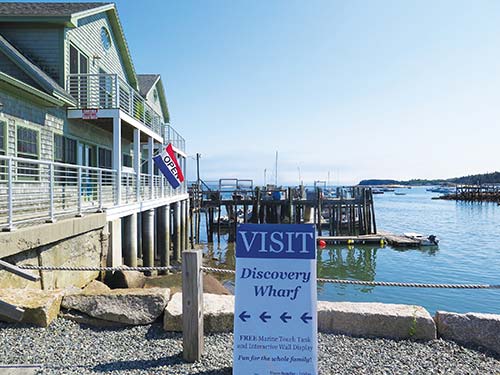
Discovery Wharf at the Maine Center for Coastal Fisheries.
After weaving your way down the Blue Hill Peninsula and crossing the soaring, oh-so-narrow bridge to Little Deer Isle, you’ve entered the realm of island living. Sure, bridges and causeways connect the points, but the farther down you drive, the more removed from civilization you’ll feel. The pace slows; the population dwindles. Fishing and lobstering are the mainstays. Lobster boats rest near many homes, and trap fences edge properties. If your ultimate destination is the section of Acadia National Park on Isle au Haut, the drive down Deer Isle to Stonington serves to help disconnect you from the mainland. To reach the park’s acreage on Isle au Haut, you’ll board the Isle au Haut ferryboat for the trip down Merchant Row to the island. In summer, you can go directly to the park’s Duck Harbor Landing; in other months, it requires a hike through the woods.
Deer Isle and Isle au Haut are inexorably linked yet distinctly separate and very different. Both seduce visitors with their rugged independence and undeveloped landscapes. Deer Isle’s main town of Stonington is a metropolis compared to Isle au Haut, with a population of about 1,200 versus fewer than 50. The sidewalks roll up relatively early in Stonington, but there’s not much even in the way of pavement on Isle au Haut. Deer Isle has stepped tentatively into the 21st century; Isle au Haut remains pretty much in the 20th—and the early 20th at that. Electricity came to Isle au Haut in 1970, and telephone service soon followed—although cellular service is spotty at best.
In addition to fisherfolk, Deer Isle is a colony of artists and artisans in equal parts due to the inspiring scenery and the inspirational Haystack Mountain School of Crafts. Top-notch galleries and working studios are found throughout the island. It’s also home to numerous small preserves, ideal for easy hiking and bird-watching, and its bevy of nearby islands beckon sea kayakers.
While dreamers and summer rusticators are plentiful, Stonington is first and foremost a working waterfront dominated by lobster and fishing boats and the remnants of once-active granite quarrying operations. It’s also the jumping-off point for trips to Isle au Haut.
The biggest attraction on Isle au Haut is a remote section of Acadia National Park that’s raw and rugged—beautiful, even breathtaking in parts. It’s not as dramatic as the Mount Desert Island section, but it seduces visitors with its simplicity, peacefulness, and lack of cars. On the trails that hug the granite shoreline and climb the forested hills, perhaps more than in any other section of the park, you can truly feel removed from civilization.
If you’re coming to this region specifically to visit Acadia National Park on Isle au Haut, plan your visit to time with the Isle au Haut Company’s boat service directly to the park (early June-mid-Sept.); otherwise it’s nearly a 10-mile round-trip from the Town Dock to Duck Harbor and back. The park boat is first come, first served, so it’s wise to be in line well before your intended departure. The park limits capacity to only 128 people, including campers, each day, although there’s no real way to enforce that. Reservations for the park’s primitive campground open in early April, and slots go quickly. Deer Isle and Little Deer Isle are primarily fishing communities with seasonal tourism centered primarily on touring galleries, sea kayaking, hiking the preserves, soaking in the small-town vibe, and savoring the island-dotted vistas. July and August are the busiest months—although the region is well off the usual tourist trail—with September being a lovely month to visit, although businesses have fewer open hours and some galleries close.
“Deer Isle is like Avalon,” wrote John Steinbeck in Travels with Charley. “It must disappear when you are not there.” Deer Isle, the name of both the island and its midpoint town, has been romancing authors and artisans for decades, but it is unmistakably real to the quarry workers and fishermen who’ve been here for centuries. These longtimers are a sturdy lot, as even Steinbeck recognized: “I would hate to try to force them to do anything they didn’t want to do.”
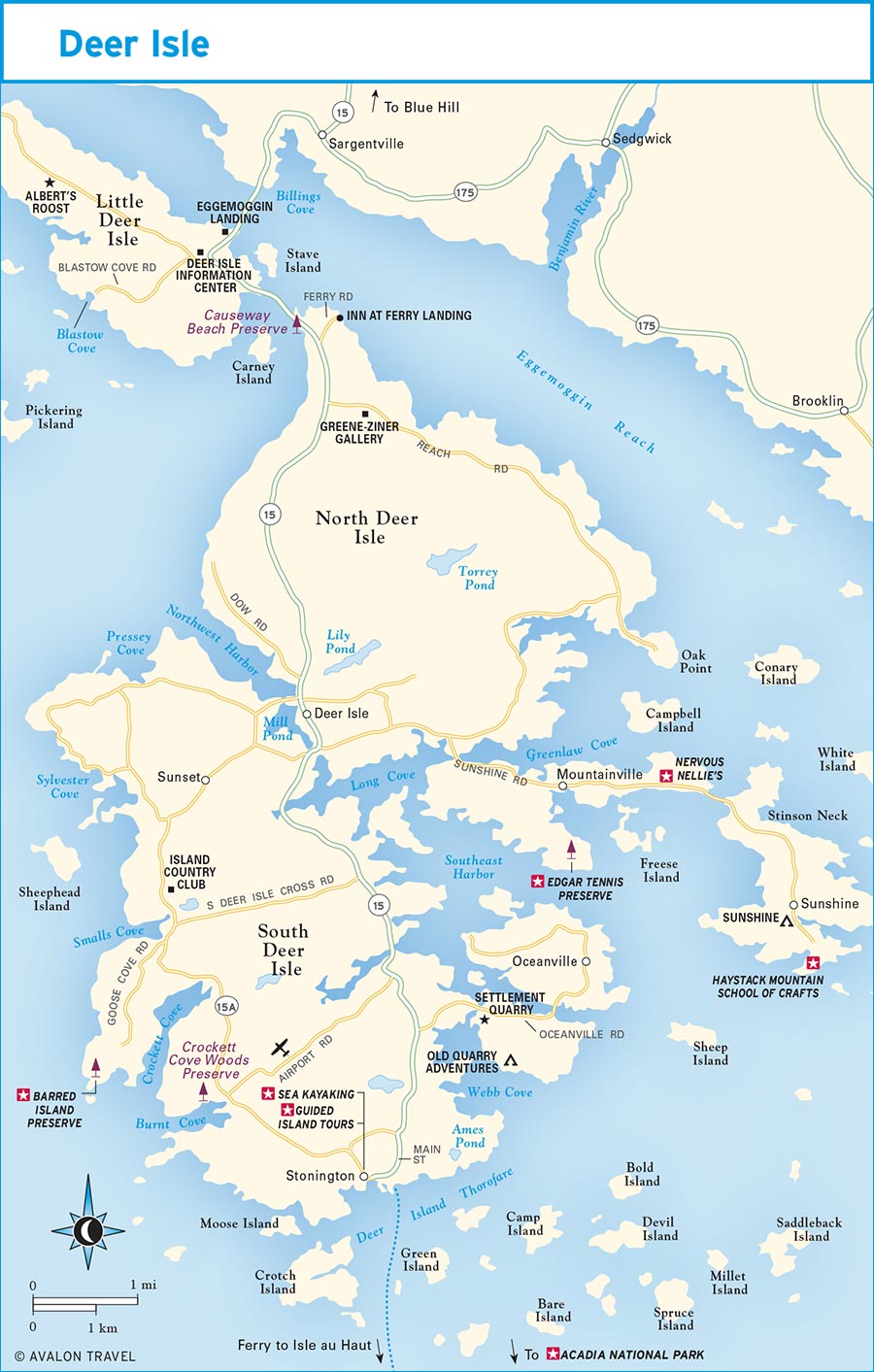
Early-18th-century maps show no name for the island, but by the late 1800s nearly 100 families lived here, supporting themselves first by farming, then by fishing. In 1789, when Deer Isle was incorporated, 80 local sailing vessels were scouring the Gulf of Maine in pursuit of mackerel and cod, and Deer Isle men were circling the globe as yachting skippers and merchant seamen. At the same time, in the once-quiet village of Green’s Landing (now called Stonington), the shipbuilding and granite industries boomed, spurring development, prosperity, and the kinds of rough high jinks typical of commercial ports the world over.
Green’s Landing became the “big city” for an international crowd of quarry workers carving out the terrain on Deer Isle and nearby Crotch Island, the source of high-quality granite for Boston’s Museum of Fine Arts, the Smithsonian Institution, a humongous fountain for John D. Rockefeller’s New York estate, and less showy projects all along the Eastern Seaboard. The heyday is long past, but the industry did extend into the 20th century, including a contract for the pink granite at President John F. Kennedy’s Arlington National Cemetery gravesite. Today, Crotch Island is the site of Maine’s only operating island granite quarry.
Measuring about nine miles north to south (plus another three miles for Little Deer Isle), the island of Deer Isle today has a handful of hamlets (including Sunshine, Sunset, Mountainville, and Oceanville) and two towns—Stonington (pop. 1,043) and Deer Isle (pop. 1,975). Road access is via Route 15 on the Blue Hill Peninsula. A huge suspension bridge, built in 1939 over Eggemoggin Reach, links the Sargentville section of Sedgwick with Little Deer Isle; from there, a sinuous 0.4-mile causeway connects to the northern tip of Deer Isle.
Deer Isle is an artisans’ enclave, anchored by the Haystack Mountain School of Crafts. Studios and galleries are plentiful, although many require noodling along back roads to find them. Stonington, a rough-and-tumble fishing port with an idyllic setting, is slowly being gentrified as more and more galleries and upscale shops open for the summer each season. Long-empty downtown buildings have recently been purchased, and locals are holding their collective breath hoping that any improvements don’t change the town too much (although most visitors could do without the car racing on Main Street at night). Already, real estate prices and accompanying taxes have escalated way past the point where many a local fisherman can hope to purchase, and in some cases maintain, a home.
Sightseeing on Deer Isle means exploring back roads, browsing the galleries, walking the trails, hanging out on the docks, and soaking in the ambience.
The renowned Haystack Mountain School of Crafts (Sunshine Rd., Deer Isle, 207/348-2306, www.haystack-mtn.org) in Sunshine is open to the public on a limited basis, but if it fits into your schedule, go. Anyone can visit the school store and dining room or walk down the central stairs to the water; to see more of the campus, take a tour (1pm Wed., $5), which includes a video, viewing works on display, and the opportunity to visit some studios. Beyond that, there are slide programs, lectures, demonstrations, and concerts presented by faculty and visiting artists on varying weeknights early June-late August. Perhaps the best opportunities are the end-of-session auctions, held on Thursday nights every 2-3 weeks, when you can tour the studios for free before the evening auction. It’s a great opportunity to buy craftwork at often very reasonable prices.
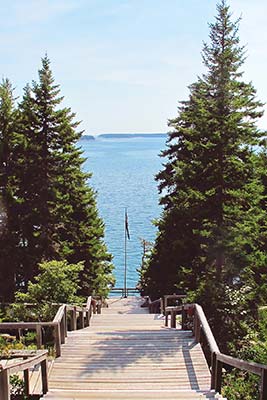
the central stairs at the Haystack Mountain School of Crafts
Part museum, part gallery, part jelly kitchen, and part tearoom: Nervous Nellie’s (600 Sunshine Rd., Deer Isle, 800/777-6845, www.nervousnellies.com, free) is all that and more. Most visitors come to purchase the hand-produced jams and jellies and, perhaps, watch them being made. Once here, they discover sculptor Peter Beerits’s “natural history museum of the imagination.” Beerits, who has an MFA in sculpture, has built a fantasy world that’s rooted in his boyhood and complements The Nervous Nellie Story, his graphic novel series. “Ten years ago, I was primarily an artist who exhibited works in galleries. Now I’m primarily a museum curator,” he says.
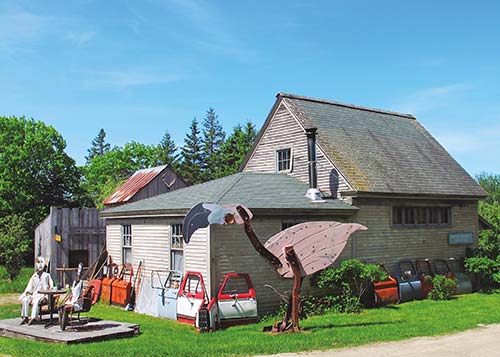
Nervous Nellie’s is the creation of sculptor Peter Beerits, who has filled the property with his works.
The buildings, fields, gardens, and woods are filled with interactive scenes and whimsical wood and metal sculptures Beerits has created from the flotsam and jetsam of everyday island life—farming implements, household furnishings, and industrial whatnots—what he calls “good junk from the dump.” Take a closer look at that dragon frolicking in the meadow: Its tail and legs are culled from four pianos, the scales are backhoe teeth, the claws are roof-ladder hooks, the neck is a potato harvester, and the head is a radar dish.
There’s an interactive western town complete with a hotel, Chinese laundry, jail, fortune-teller, sheriff’s office, blacksmith shop, and the Silver Dollar Saloon. Inside the saloon, Wild Bill Hickok is playing his last hand of cards, his back to a gunman sneaking through the back door. “Hickok made the mistake one time of sitting with his back to a door, not the wall,” Beerits says, adding that the hand he holds, two aces and two eights, is now known as the “dead man’s hand” in poker. It’s that kind of detail that adds a touch of reality to the scenes, and it’s the opportunity to grab a seat at the table that engages visitors and keeps the cameras clicking. The West fades into the Mississippi Delta, where blues music draws visitors into Red’s Lounge, where a pianist and guitarist crank out the blues while a couple flirts in a corner booth.
Beerits moved the original Hardy’s Store here. Like a living-history museum, it provides a glimpse into island life decades ago. No detail is overlooked, from the hot dogs and buns in the steamer to the pickled eggs on the counter, from Neville Hardy at the register to the women seated out front eyeing the gas pump. As in every exhibit, fans have left notes, often illustrated, sharing their thoughts and impressions.
Many visitors take in these sights and then settle into the café for a snack, not realizing that there’s more to see. In the woods behind, King Arthur’s knights in shining armor, some larger than life, guard and inhabit the Grail Castle. A feast is in progress, and the Grail maidens are parading through the hall bearing holy objects. The woodlands also harbor a chapel and musicians.
You can easily spend an hour here, and there’s no admission; wander freely. Ask about the free tours Beerits usually offers on Sundays at 1pm.
The property is also home to Nervous Nellie’s Jams and Jellies, known for outstanding, creative condiments. You can peek into the kitchen to see the jams being made. The best time to come is 9am-5pm daily May-early October, when the shop operates the casual Mountainville Cafe, serving tea, coffee, and scrumptious scones—with, of course, delicious Nervous Nellie’s products. Sampling is encouraged. Stock up, because they’re sold in only a few shops. Also sold is a small, well-chosen selection of Maine products. Really, trust me, you must visit this place.
There’s more to the 1830 Salome Sellers House (416 Sunset Rd./Rte. 15A, Sunset Village, 207/348-6400, www.dis-historicalsociety.org, 1pm-4pm Wed., Thurs., and Fri. mid-June-mid-Sept., donation) than first meets the eye. A repository of local memorabilia, archives, and intriguing artifacts, it’s also the headquarters of the Deer Isle-Stonington Historical Society. Sellers, matriarch of an island family, was a direct descendant of Mayflower settlers. She lived to be 108, a lifetime spanning 1800-1908, earning the record for oldest recorded Maine resident. The house contains Sellers’s furnishings, and in a small space in the rear is a fine exhibit of baskets made by Maine Native Americans. Behind the house are the archives, heritage gardens, and an exhibit hall filled with nautical artifacts. Bringing all this to life are enthusiastic volunteer guides, many of them island natives, who love to provide tidbits about various items. Seafarers’ logs and ship models are particularly intriguing, and don’t miss the 1920s peapod, the original lobster boat on the island. The house is just north of the Island Country Club and across from Eaton’s Plumbing. Hours vary season to season; call for the current schedule.
Close to the Stonington waterfront, the Deer Isle Granite Museum (51 Main St., Stonington, 207/367-6331, www.deerislegranitemuseum.org, 9am-5pm Sat.-Tues. and Thurs. July-Aug.) was established to commemorate the centennial of the quarrying business hereabouts. The best feature of the small museum is a 15-foot-long working model of Crotch Island, center of the industry, as it appeared at the turn of the 20th century. Flatcars roll, boats glide, and derricks move—it all looks very real. Donations are welcome.
Another downtown Stonington attraction is a Lilliputian complex known as the Miniature Village. Beginning in 1947, the late Everett Knowlton created a dozen and a half replicas of local buildings and displayed them on granite blocks in his yard. Since his death, they’ve been restored and put on display each summer in town—along with a donation box to support the upkeep. The village is set up on East Main Street (Rte. 15), below Hoy Gallery.
A fine view of Pumpkin Island Light can be had from the cul-de-sac at the end of the Eggemoggin Road on Little Deer Isle. If heading south on Route 15, bear right at the information booth after crossing the bridge and continue to the end.
The purpose of the Maine Center for Coastal Fisheries (13 Atlantic Ave., Stonington, 207/367-2708, www.penobscoteast.org, 10am-4pm Sun.-Fri., free) is “to energize and facilitate responsible community-based fishery management, collaborative marine science, and sustainable economic development to benefit the fishermen and the communities of Penobscot Bay and the Eastern Gulf of Maine.” Bravo to that! At the Discovery Wharf center are educational displays and interactive exhibits, including a touch tank, highlighting Maine fisheries and the Gulf of Maine ecosystem. One of the driving forces behind the venture is Ted Ames, a past recipient of a $500,000 MacArthur Fellowship “genius grant.”
Thanks to the presence and influence of Haystack Mountain School of Crafts, super-talented artists and artisans lurk in every corner of the island. Most galleries are tucked away on back roads, so watch for roadside signs. Many have studios open to the public where you can watch the artists at work. Stonington hosts its Art Walk on the first Friday of the month; Deer Isle village’s is on the third Friday.
Alfred’s Roost (360 Eggemoggin Rd., 207/348-6699) is a fun gallery and working glass studio in an old schoolhouse. Ask Dusty Eagen to share mascot Alfred Peabody’s life story.
The Greene-Ziner Gallery (73 Reach Rd., 207/348-2601, www.melissagreene.com) is a double treat. Melissa Greene turns out incredible painted and incised pottery—she’s represented in the Smithsonian’s Renwick Gallery—and Eric Ziner works magic in metal sculpture and furnishings. Your budget may not allow for one of Melissa’s pots (in the four-digit range), but I guarantee you’ll covet them. The gallery also displays the work of several other local artists.
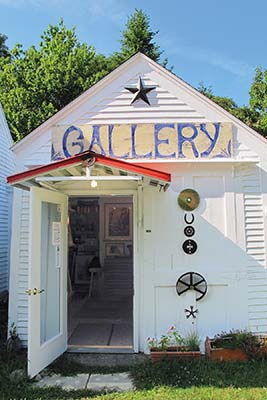
Galleries pepper Deer Isle.
The Hutton Gallery (89 N. Deer Isle Rd./Rte. 15, 207/348-6171, www.huttongallery.com) offers a nice range of fine art and craftwork, including prints, jewelry, paintings, basketry, glass, and fiber art.
The Frederica Marshall Gallery (81 N. Deer Isle Rd., 207/348-2782, www.fredericamarshall.com) is a multifaceted find. Marshall is a master brush painter who delights in explaining Japanese sumi-e work and demonstrating the brushes that vary from a cat’s whisker to four horsetails in size. She also has a classroom and offers workshops ranging from two hours to four days in length. Her husband, Herman Kidder, operates Kidder Forge on the same property. His knives forged from old tools are available in the gallery.
One of the island’s premier galleries is Elena Kubler’s The Turtle Gallery (61 N. Deer Isle Rd./Rte. 15, 207/348-9977, www.turtlegallery.com), in a handsome space formerly known as the Old Centennial House Barn (owned by the late Haystack director Francis Merritt) and the adjacent farmhouse. Group and solo shows of contemporary paintings, prints, and crafts are hung upstairs and down in the barn; works by gallery artists are in the farmhouse; and there’s usually sculpture in the gardens both in front and in back. It’s just north of Deer Isle Village, across from the Shakespeare School.
In the village, Deer Isle Artists Association (5 Main St., 207/348-2330, www.deerisleartists.com) features two-week exhibits of paintings, prints, drawings, and photos by member artists.
Also downtown is Gallery Mozelle (4 Main St., 207/348-2787, http://mozellefinejewelry.com), showing fine jewelry as well as works in varied media, including clay, fibers, and glass.
Even if you can’t afford to buy, at least peek into Devta Doolan (3 Main St., 917/361-1861), a very high-end handcrafted jewelry studio.
Just a bit south is John Wilkinson Sculpture (41 Church St., 207/348-2363, www.sculptor1.com), open by chance or appointment. Wilkinson works in concrete, wood, and plaster.
Detour down Sunshine Road to visit Peter Beerits Sculpture at Nervous Nellie’s (600 Sunshine Rd., 800/777-6845, www.nervousnellies.com), a world of whimsy that will entertain all ages. If the timing works, combine it with the Wednesday tour at Haystack.
Cabinetmaker Geoffrey Warner features his work at Geoffrey Warner Studio (431 N. Main St., 207/367-6555, www.geoffreywarnerstudio.com). Warner mixes classic techniques with contemporary styles and Eastern, nature-based, and arts and crafts accents to create some unusual and rather striking pieces. He also crafts the budget-friendly ergonomic Owl stool and offers kits and workshops.
The gWatson Gallery (68 Main St., 207/367-2900, www.gwatsongallery.com) is a fine-art gallery representing a number of top-notch painters and printmakers. Occasionally it hosts live performances.
More paintings, many in bold, bright colors, can be found at Jill Hoy’s Hoy Gallery (80 Main St., 207/367-2368, www.jillhoy.com).
On the other end of Main Street, Marlinespike Chandlery (58 W. Main St., 207/348-2521, www.marlinespike.com) specializes in ropework, both practical and fancy.
A bit off the beaten path but worth seeking out is the Siri Beckman Studio (115 Airport Rd., 207/367-5037, www.siribeckman.com), Beckman’s home studio-gallery featuring her woodcuts, prints, and watercolors.
Foresighted benefactors have set aside precious acreage for respectful public use on Deer Isle. The Nature Conservancy (207/729-5181, www.nature.org) owns two properties: Crockett Cove Woods Preserve and Barred Island Preserve. The conscientious steward of other local properties is the Island Heritage Trust (420 Sunset Rd., Sunset, 207/348-2455, www.islandheritagetrust.org, 8am-4pm Mon.-Fri.). At the office you can pick up notecards, photos, T-shirts, and helpful maps and information on hiking trails and nature preserves. Proceeds benefit the Island Heritage Trust’s efforts; donations are appreciated.
One of the easiest, shortest walks in the area leads to an impressive vista. It begins from the parking lot on Oceanville Road, a little less than one mile off Route 15 and marked by a carved granite sign. It’s about a five-minute walk to the top of the old quarry, where the viewing platform (aka the “throne room”) takes in the panorama—all the way to the Camden Hills on a good day. In early August, wild raspberries are an additional enticement. Three short loop trails lead into the surrounding woods from here. A map is available in the trailhead box.
The 145-acre Tennis Preserve (sunrise-sunset daily), off Sunshine Road, has very limited parking, so don’t try to squeeze in if there isn’t room; schedule your visit for another hour or day. But do go, and bring at least a snack if not a full picnic to enjoy on one of the convenient rocky outcroppings (be sure to carry out what you carry in). Allow at least 90 minutes to enjoy the walking trails, one of which skirts Pickering Cove, providing sigh-producing views. Another trail leads to an old cemetery. Parts of the trails can be wet, so wear appropriate footwear. Bring binoculars for bird-watching. To find the preserve, take Sunshine Road 2.5 miles to Tennis Road, and follow it to the preserve.
The 38-acre preserve, a gift in 2000 from Judy Hill to the Island Heritage Trust, comprises old farmland, woodlands, clam flats, a salt marsh, and granite shorefront. Three walking trails connect in a 1.5-mile loop, with the Shore Trail section edging Greenlaw Cove. As you walk along the waterfront, look for the islands of Mount Desert rising in the distance and seals basking on offshore ledges. Do not walk across the salt marsh, and try to avoid stepping on beach plants. To find the preserve, take Sunshine Road 1.2 miles and then bear left at the fork onto Greenlaw District Road. The preserve’s parking area is just shy of one mile down the road. Park only in the parking area, not on the paved road.
Donated to the Nature Conservancy by benevolent, eco-conscious local artist Emily Muir, 98-acre Crockett Cove Woods Preserve (sunrise-sunset daily year-round) is Deer Isle’s natural gem—a coastal fog forest laden with lichens and mosses. Four interlinked walking trails cover the whole preserve, starting with a short nature trail. Pick up the helpful map-brochure at the registration box. Wear rubberized shoes or boots, and respect adjacent private property. From Deer Isle Village, take Route 15A to Sunset Village. Go 2.5 miles to Whitman Road, and then to Fire Lane 88.
Owned by the Nature Conservancy but managed by the Island Heritage Trust, Barred Island Preserve was donated by Carolyn Olmsted, grandniece of noted landscape architect Frederick Law Olmsted, who summered nearby. A former owner of adjacent Goose Cove Lodge donated an additional 48 acres of maritime boreal fog forest. A single walking trail, one mile long, leads from the parking lot to the point, with spectacular views encompassing Isle au Haut to Mark Island and including Saddleback Ledge Light, 14 miles distant. At low tide, and when eagles aren’t nesting, you can continue out to Barred Island. (If eagles are nesting on the island, access will be restricted.) Another trail skirts the shoreline of Goose Cove, before retreating inland and rejoining with the main trail. Allow at least 1.5 hours for the round trip to the shore. Check a tide chart if you plan to continue onto the island; you can access it about 2.5 hours on either side of high tide. To get to the preserve, follow Route 15A to Goose Cove Road, and then continue to the parking area on the right. If it’s full, return another day. No dogs are permitted on this preserve.
The Stonington Conservation Commission administers this town-owned preserve, where more than 47 bird species have been identified (bring binoculars). It comprises four habitats: upland spruce forest, lowland spruce-mixed forest, freshwater marsh, and saltwater marsh. A self-guided nature trail is accessible off Airport Road (off Rte. 15 at the intersection with Lily’s Café). Look for the Nature Trail sign just beyond the medical center. The detailed self-guided trail brochure, available at the trailhead registration kiosk, is illustrated with drawings by noted artist Siri Beckman.
Ames Pond is neither park nor preserve, but it might as well be. On a back road close to Stonington, it’s a mandatory stop in July-August, when the pond wears a blanket of pink and white water lilies. From downtown Stonington, take Indian Point Road just under one mile east to the pond.
If you’re itching to dip your toes in the water, stop by Causeway Beach along the causeway linking Little Deer Isle to Deer Isle. It’s popular for swimming and is also a significant habitat for birds and other wildlife. On the other side of Route 15 is Scott’s Landing, with more than 20 acres of fields, trails, and shorefront.
The Maine Coast Heritage Trust (www.mcht.org) owns 985-acre Marshall Island, the largest undeveloped island on the Eastern Seaboard. Since acquiring it in 2003, the trust has added 10 miles of hiking trails. After exploring, picnic on Sand Cove beach on the southeastern shore. You can charter transportation through Old Quarry Ocean Adventures (Stonington, 207/367-8977, www.oldquarry.com) or Captain Steve Johnson’s Capt. Steve’s Boat Tours (207/460-8679 or 207/367-2991, http://deerislecabinwithboattours.com). Primitive camping is available by reservation (207/729-7366) at designated sites; fires require a permit (207/827-1800).
The Island Heritage Trust (402 Sunset Rd., Sunset, 207/348-2455, www.islandheritagetrust.org), along with the Stonington and Deer Isle Conservation Commissions, sponsors a Walks and Talks series. Guided walks cover topics such as “Bird Calls for Beginners,” “Salt Marsh Ecology,” and “Butterflies, Bees, and Biodiversity.” Call for information and reservations.
The waters around Deer Isle, with lots of islets and protected coves, are extremely popular for sea kayaking, especially off Stonington.
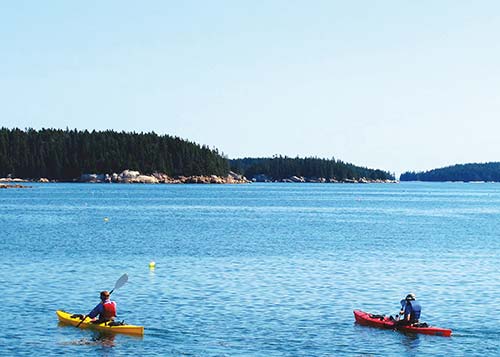
Sea kayakers favor Deer Isle’s craggy coastline.
If you sign up with the Maine Island Trail Association (207/761-8225, www.mita.org,), you’ll receive a handy manual that steers you to more than a dozen islands in the Deer Isle archipelago where you can camp, hike, and picnic—eco-sensitively, please. Annual membership is $45/individual, $65/family.
Boat traffic can be a bit heavy at the height of summer, so to best appreciate the tranquility of this area, try this in September after the Labor Day holiday. Nights can be cool, but days are likely to be brilliant. Remember that this is a working harbor.
The six-mile paddle from Stonington to Isle au Haut is best left to experienced paddlers, especially since the local lobstermen refer to kayakers as “speed bumps.”
For equipment rentals or guided trips, Old Quarry Ocean Adventures (Stonington, 207/367-8977, www.oldquarry.com) is especially helpful and provides many services for kayakers. Old Quarry is off Oceanville Road, less than one mile from Route 15, just before you reach the Settlement Quarry preserve. It’s well signposted.
The island’s only major freshwater swimming hole is the Lily Pond, northeast of Deer Isle Village. Just north of the Shakespeare School, turn into the Deer Run Apartments complex. Park and take the path to the pond, which has a shallow area for small children.
About two miles south of Deer Isle Village, watch for the large sign on the left for the Island Country Club (Rte. 15A, Sunset, 207/348-2379, early June-late Sept.), a nine-hole public golf course that has been here since 1928. Also at the club are three Har-Tru tennis courts. The club’s cheeseburgers and salads are among the island’s best bargain lunches.
The biggest operation is Old Quarry Ocean Adventures (Stonington, 207/367-8977, www.oldquarry.com), with a broad range of outdoor adventure choices. Bill Baker’s ever-expanding enterprise rents canoes, kayaks, sailboats, bikes, moorings, platform tent sites, and cabins. Bicycle rentals are $23 per day or $115 per week. Sea kayak rentals are $72 per day for a single, $88 for a tandem. Two-hour, half-day, and weekly rentals are available. Overnight 24-hour rental is available for a 10 percent surcharge. Other options include canoes, SUPs, rowboats, and sailboats; check the website for details. For all boat rentals, you must demonstrate competency in the vessel. They’ll deliver and pick up anywhere on the island for a fee of $31 each way; it’s $52 for off-island delivery. All-day guided sea-kayaking tours are $135 per person; a half-day tour is $67 per person. Plenty of other options are available, including sunset tours and family trips.
A Registered Maine Guide leads overnight kayaking camping trips on nearby islands. Rates, for kayak rental and guide, begin around $300 per adult for one night, with a three-person minimum; add meals for $12.50 per person. If you’re bringing your own kayak, you can park your car ($7/night up to two nights, $6/night for three or more nights) and launch from here ($5/boat for launching); they’ll take your trash and any trash you find. Old Quarry is off the Oceanville Road, less than a mile from Route 15, just before you reach the Settlement Quarry preserve. It’s well signposted.
The Miss Lizzie departs at 2pm Monday-Saturday mid-June-late August from the Isle au Haut Boat Company (Seabreeze Ave., Stonington, 207/367-5193 or 207/367-6516, www.isleauhaut.com) dock in Stonington for a narrated 1.25-hour Lobster Fishing Scenic Cruise, during which the crew hauls a string of lobster traps. Cost is $22 adults, $8 under age 12. Special puffin and lighthouse cruises are offered on a limited basis. Another option is to cruise over and back to Isle au Haut without stepping foot off the boat ($22 adults). Reservations are advisable, especially in July-August. Dockside parking is around $10, or find a spot in town and save the surcharge.
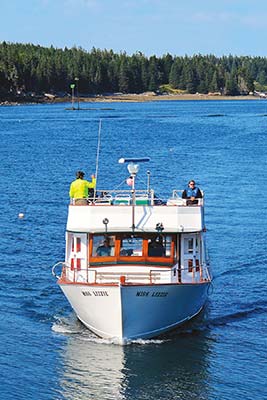
the Miss Lizzie of Isle au Haut Boat Company
Captain Walter Reed’s Guided Island Tours (207/348-6789, www.guidedislandtours.com, no credit cards) aboard the Gael are custom designed for a maximum of four passengers. Walt is a Registered Maine Guide and professional biologist who also is a steward for Mark Island Lighthouse and several uninhabited islands in the area. He provides in-depth perspective and the local scoop. The cost is $35 per person for the first hour plus $25 per person for each additional hour; kids under 12 are half price. Box lunches are available for an additional fee. Reservations are required.
Yet another aspect of the Old Quarry Ocean Adventures (Stonington, 207/367-8977, www.oldquarry.com) empire are sightseeing tours on the Nigh Duck. The three-hour trips, one in the morning (9am-noon) and one in the afternoon (1pm-4pm), are $47 adults and $36 under age 12. Both highlight the natural history of the area as Captain Bill navigates the boat through the archipelago. Lobster traps are hauled on both trips (but not on Sunday); the morning trip visits Isle au Haut. The afternoon excursion features an island swimming break in a freshwater quarry. Also available is a 1.5-hour sunset cruise, departing 30 minutes before sunset, for $40 adults and $30 under age 12. And if that’s not enough, Old Quarry also offers puffin-watching, lighthouse, and island cruises, with rates beginning at $72 adults, $52 children. Of course, if none of this floats your boat, you can also arrange for a custom charter for $205 per hour.
Old Quarry also offers a number of special trips in conjunction with Island Heritage Trust. Most are noted on Old Quarry’s website, but for reservations or more info, call 207/348-2455.
Cruise through East Penobscot Bay aboard the mail boat Katherine (207/701-9316, $26 adults, $13 under age 12), which departs the Deer Isle Yacht Club at 9:30am Monday-Saturday, for a two-hour excursion taking in Eagle, Butter, Barred, and Great Spruce Head Islands. Call for reservations, parking details, and to confirm the time.
Former Stonington harbormaster Captain Steve Johnson and his Australian shepherd, Boo, enjoy sharing Stonington Harbor’s highlights aboard the Bert & I (207/460-8679 or 207/367-2991, http://deerislecabinwithboattours.com). Harbor, lighthouse, island, seal-watching, and sunset tours range 1-2 hours. Ask about his drop-off service to Green Island, where you can spend a few hours exploring, picnicking, and swimming in a freshwater quarry. From about $25 per person.
Stonington’s National Historic Landmark, the 1912 Opera House (207/367-2788, www.operahousearts.org), is home to Opera House Arts, which hosts films, plays, lectures, concerts, family programs, and workshops year-round.
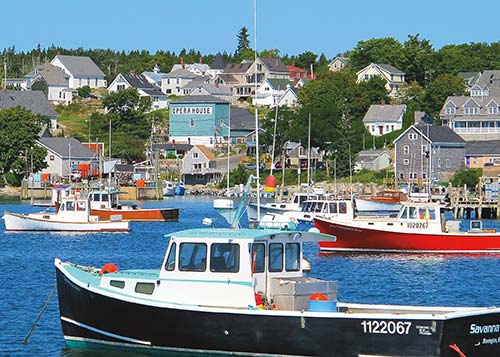
Stonington’s harbor
Bird-watchers flock to Deer Isle in mid-May for the annual Wings, Waves & Woods Weekend (www.deerisle.com).
Mid-June, when lupines in various shades of pink and purple seem to be blooming everywhere, brings the Lupine Festival (www.deerisle.com), a weekend event that includes art openings and shows, boat rides, a private garden tour, and entertainment ranging from a contra dance to movies.
Early July-September is the season for Art Walks, an open-house night held on the first Friday evening of each month in Stonington and the third Friday of each month in Deer Isle Village.
Mid-July brings the Stonington Lobsterboat Races (207/348-2804), very popular competitions held in the harbor, with lots of possible vantage points. Stonington is one of the major locales in the lobster-boat race circuit.
The Peninsula Potters Studio Tour and Sale (www.peninsulapotters.com) is held in October, when more than a dozen potters from Blue Hill to Stonington welcome visitors.
Want to meet locals and learn more about the area? Island Heritage Trust (www.islandheritagetrust.org) sponsors a series of walks, talks, and tours late May-mid-September. For information and reservations, call 207/348-2455.
The greatest concentration of shops is in Stonington, where galleries, clothing boutiques, and eclectic shops line Main Street.
In “downtown” Deer Isle Village, Candy and Jim Eaton have taken over The Periwinkle (8 Main St., Deer Isle, 207/348-2256) from Neva Beck. They’re continuing the shop’s quirky yet fun inventory: a mix of books, handcrafts, and niceties.
Prints & Reprints (31 Main St., Stonington, 207/367-5821) is filled with used and antiquarian books along with artwork and a bit of this and that.
Just beyond the Opera House, Dockside Books & Gifts (62 W. Main St., Stonington, 207/367-2652) carries just what its name promises, with a specialty in marine and Maine books. The rustic two-room shop has spectacular harbor views.
Find imported women’s clothing from Nigerian, Tibetan, and Indian cottage industries; unique jewelry; and unusual notecards at The Dry Dock (24 Main St., Stonington, 207/367-5528).
The Nature Shop at Island Heritage Trust (420 Sunset Rd., Deer Isle, 207/348-2455) carries nature- and wildlife-related books, clothing, and other items.
Options for dining are few, and restaurants suffer from a lack of consistency. Patience is more than a virtue here; it’s a necessity.
Water’s Edge Wines (6 Thurlow’s Hill Rd., Stonington, 207/367-6348) sells wine, beer, baked goods, and specialty food. It’s also a great spot to enjoy or pick up sandwiches for lunch (11am-3pm Mon-Fri.).
Coffee zealots praise 44 North Coffee (70 Main St., Stonington, 207/348-3043, https://44northcoffee.com, 6:30am-5pm Mon.-Tues. and Sat, 6:30am-8:30pm Wed.-Fri., 8am-2pm Sun.), a spacious café serving coffee and pastries. On Wednesday through Friday evenings, it also serves beer and wine. 44 North also operates a tiny shop out of its roastery (7 Main St., Deer Isle, 207/348-5208, 8am-4pm Mon.-Fri., 8am-2pm Sat.), where you can grab a cup of Joe and a baked treat.
On a fine afternoon, there’s no better place to hang out and sip coffee than the Espresso Bar at the Inn on the Harbor (45 Main St., Stonington, 800/942-2420, 11am-4pm daily). Baked goods and panini are available.
Burnt Cove Market (Rte. 15, Stonington, 207/367-2681, 6am-9pm daily) sells pizza, fried chicken, and sandwiches, plus beer and wine.
The Deer Isle Night Market takes place 4pm-6pm Tuesdays, late May through November, when food vendors set up at 11 Main Street.
The Fairway Café (442 Sunset Rd., Deer Isle, 207/348-2379, www.islandcountryclub.net, 8am-2pm daily), located at the country club, is a good bet for a reasonably priced breakfast or lunch.
The Island Community Center (6 Memorial Ln., just off School St., Stonington) is the locale for the lively Island Farmers Market (10am-noon Fri. late May-late Sept.), with more than 50 vendors selling smoked and organic meats, fresh herbs and flowers, produce, gelato and yogurt, maple syrup, jams and jellies, fabulous breads and baked goods, chocolates, ethnic foods, crafts, and so much more. Go early; items sell out quickly.
The Island Culinary & Ecological Center (www.edibleisland.org), comprising area chefs, aims to create a high-level cooking school and also supports the region as a culinary destination. It offers occasional workshops and programs, as well Top Chefs Dinners featuring a five-course meal prepared by notable chefs.
Harbor Cafe (36 Main St., Stonington, 207/367-5099, 6am-8pm daily, $8-20) is the place to go for breakfast (you can eavesdrop on the local fisherfolk if you’re early enough), but it’s also open for lunch and dinner. Food quality varies, as does the service; it’s best to stick to the basics or go for the all-you-can-eat fish fry on Friday nights.
Fried seafood, lobsters, burgers, ice cream, and other staples are available at Madelyn’s Drive In & Takeout (495 N. Deer Isle Rd./Rte. 15, 207/348-9444, 11am-7pm Tues.-Sun.), a popular and inexpensive family spot with picnic tables and a playground. Simple sandwiches, burgers, and dogs begin around $3, fried seafood baskets begin around $12.
The views are top-notch from the dining area at the harbor-front Stonecutters Kitchen (5 Atlantic Ave., Stonington, 207/367-2442, www.stonecutterskitchenme.com, 11am-8pm daily, $10-20), a self-service deli offering sandwiches, fried fare, and good pizza. Entrance is through the Harbor View Store (207/367-2530, 3am-9pm Mon.-Sat., 3am-6pm Sun.), where you also can pick up breakfast sandwiches in the wee hours.
The Whale’s Rib Tavern (20 Main St./Sunset Rd., Deer Isle Village, 207/348-5222, 5pm-8:15pm Tues.-Sat., $18-30) is a comfy, white-tablecloth tavern with a rustic feel in the lower level of the Pilgrim’s Inn. The American menu always includes a vegan or vegetarian choice. Friday nights feature fish-and-chips from 4pm to 7pm. On Monday nights, the tavern serves a traditional shore dinner; reservations required.
Gaze over lobster boats toing-and-froing around spruce-and-granite-fringed islands and out to Isle au Haut from S Aragosta (27 Main St., Stonington, 207/367-5500, www.aragostamaine.com, 11am-3pm Mon.-Sat., 5pm-9pm daily, and 10am-3pm Sun., $21-30), a culinary bright spot fronting on the harbor in downtown Stonington. The emphasis is on seafood, but chef Devin Finigan’s oft-changing New American menu draws from what’s currently available from local farms, foragers, and fishermen. She also makes her own charcuterie, flavored salts, and ice cream. Lunch is served on the harbor-hugging deck, dinner in the harbor-view dining room; live music, tapas, and cocktails are featured on the deck 5pm-8pm Thursday-Saturday. Reservations are wise.
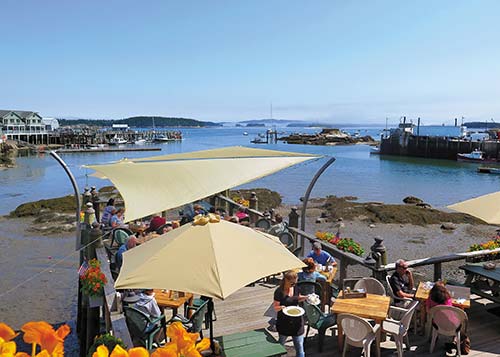
Aragosta offers wharf seating for lunch.
Pilgrim’s Inn (20 Main St., Deer Isle, 207/348-6615, www.pilgrimsinn.com, early May-mid-Oct., $149-269) comprises a beautifully restored colonial building with 12 rooms and three newer dog-friendly cottages overlooking the peaceful Mill Pond. The inn, listed in the National Register of Historic Places, began life in 1793 as a boardinghouse named The Ark. Rates include a full breakfast. The Whale’s Rib Tavern serves dinner ($18-30).
S The Inn on the Harbor (45 Main St., Stonington, 207/367-2420 or 800/942-2420, www.innontheharbor.com, $170-275) is exactly as its name proclaims—its expansive deck hangs right over the harbor. Although recently updated, the 1880s complex still has an air of unpretentiousness. Most of the 14 guest rooms and suites, each named after a windjammer, have fantastic harbor views and private or shared decks where you can keep an eye on lobster boats, small ferries, windjammers, and pleasure craft; binoculars are provided. Street-side rooms can be noisy at night. Rates include a continental breakfast. An espresso bar is open 11am-4:30pm daily, and a café serves lunch during summer. Nearby are antiques, gift, and crafts shops, and guest moorings are available. The inn is open all year.
Eggemoggin Reach is almost on the doorstep at The Inn at Ferry Landing (77 Old Ferry Rd., Deer Isle, 207/348-7760, www.ferrylanding.com, $130-185), overlooking the abandoned Sargentville-Deer Isle ferry wharf. The view is wide open from the inn’s great room, where guests gather to read, play games, talk, and watch passing windjammers. Professional musician Gerald Wheeler has installed two grand pianos in the room; it’s a treat when he plays. His wife, Jean, is the hospitable innkeeper, managing three water-view guest rooms and a suite. A harpsichord and a great view are big pluses in the suite. The Mooring, an annex that sleeps five, is rented by the week ($1,200 without breakfast). The inn is open year-round except Thanksgiving and Christmas; Wi-Fi is available throughout.
Right in downtown Stonington, just across the street from the harbor, is Boyce’s Motel (44 Main St., Stonington, 207/367-2421 or 800/224-2421, www.boycesmotel.com, year-round, $85-165). The 11 units have refrigerators; some have kitchens and living rooms, and one has two bedrooms. Across the street, Boyce’s has a private harbor-front deck for its guests. Ask for rooms well back from Main Street to lessen street noise. Some rooms are pet friendly ($15/stay); restrictions apply.
The rustic-bordering-on-primitive Deer Isle Hostel (65 Tennis Rd., Deer Isle, 207/348-2308, www.deerislehostel.com, no credit cards) occupies a site near the Tennis Preserve. It’s completely off the grid, with a pump in the kitchen for water, an outhouse, outdoor hot water-can shower, and solar-powered lighting. The goal is sustainability, not profit. Owner Dennis Carter, a Surry, Maine, native and local stoneworker and carpenter, expects guests to work in the extensive organic gardens; the produce is used in shared meals prepared on a woodstove, the sole source of heat. The hostel has a three-story timber-frame design. Carter hand-cut the granite for the basement, and the timbers in the nail-free frame are hand-hewn from local blown-down spruce. Communal dinners are available nightly—guests either help with preparation or make a $7-10 contribution. Accommodations include private and dorm rooms ranging from $25 per person to $70 per room. Kids 14 and younger are $15. Bedding is provided; sleeping bags are not permitted.
Old Quarry Ocean Adventures Bunkhouse (130 Settlement Rd., Stonington, 207/367-8977, www.oldquarry.com) sleeps up to eight in three private rooms for $62-82 double; weekly rates as well as whole-building rates are available. Guests use the campground bathhouse facilities. Bring your own sleeping bag or linens, or rent them for $4.
When you truly want to escape the trappings of civilization, make reservations for one of four rental cottages on Eagle Island (207/701-9316, www.eagleislandrentals.com), located in East Penobscot Bay, about 2.5 miles off Deer Isle. The private island is off the grid, and not all cottages have indoor plumbing, but it is a very special experience for those who don’t mind roughing it with basic comforts. Rates range $700/week for a cozy camp with outhouse and solar shower to $2,000/week for a six-bedroom former boarding home with indoor plumbing.
Plan ahead if you want to camp at Old Quarry Ocean Adventures Campground (130 Settlement Rd., Stonington, 207/367-8977, www.oldquarry.com), which has both oceanfront and secluded platform sites for tents and just three RV sites. Rates range $41-62 for two people, plus $19 for each additional adult, varying with location and hookups. Children ages 5-11 are $6.50. Leashed pets are permitted ($2/stay); Wi-Fi is $3 per stay. Parking is designed so that vehicles are kept away from most campsites, but you can use a garden cart to transport your equipment between your car and your site. The campground is adjacent to the Settlement Quarry preserve.
The Deer Isle-Stonington Chamber of Commerce (207/348-6124, www.deerislemaine.com) has a summer information booth on a grassy triangle on Route 15 in Little Deer Isle, 0.25 mile after crossing the bridge from Sargentville (Sedgwick).
Across from the Pilgrim’s Inn is the Chase Emerson Memorial Library (Main St., Deer Isle Village, 207/348-2899). At the tip of the island is the Stonington Public Library (Main St., Stonington, 207/367-5926).
Find public restrooms at the Atlantic Avenue pier and the Stonington Town Hall on Main Street, at the Chase Emerson Library in Deer Isle Village, and behind the information booth on Little Deer Isle.
Deer Isle Village is about 12 miles or 25 minutes via Route 15 from Brooksville. Stonington is about 6 miles or 15 minutes via Route 15 from Deer Isle Village.
Eight miles off Stonington lies Isle au Haut. Approximately 3,200 acres, roughly half the island, belongs to Acadia National Park. Pronounced variously as “I’ll-a-HO” or “I’LL-a-ho,” the island has nearly 20 miles of hiking trails, excellent birding, and a tiny village. The most recent U.S. census counted the population as 73, but islanders say it hovers around 40 souls. Most of those who call Isle au Haut home year-round eke out a living from the sea. Each summer, the population temporarily swells with day-trippers, campers, and cottagers. Come autumn, it settles in to the measured pace of life on an offshore island.
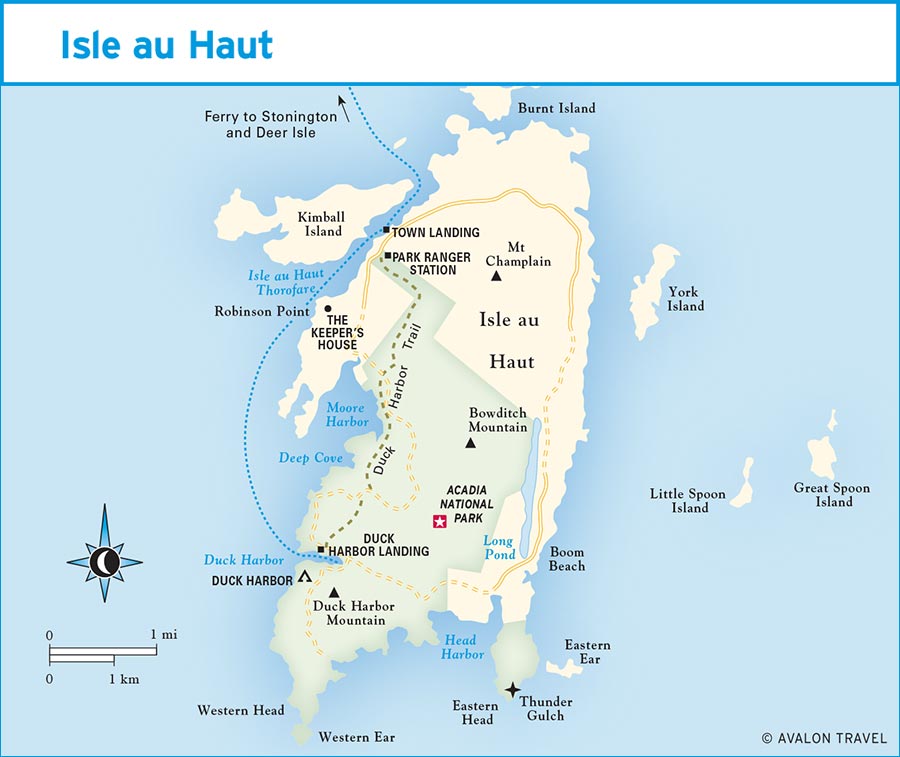
Native American shell middens document 5,000 years of use. Samuel de Champlain, threading his way through this archipelago in 1604 and noting the island’s prominent central ridge, named it Isle au Haut (High Island). Appropriately, the tallest peak (543 feet) is now named Mount Champlain.
Peletiah Barter, the island’s first European settler, arrived in 1792 and his descendants still live and work here. Incorporated on its own in 1874, Isle au Haut earned a world record during World War I, when all residents were members of the Red Cross. Electricity came in 1970, and phone service in 1988.
More recent fame has come to the island thanks to island-based authors Linda Greenlaw, of Perfect Storm fame, who wrote The Lobster Chronicles, and more recently Kate Shaffer, of Black Dinah Chocolatiers, who shared her recipes along with island tales in Desserted. Although both books piqued interest in the island, Isle au Haut remains uncrowded and well off the beaten tourist track.
Most of the southern half of the six-mile-long island belongs to Acadia National Park, thanks to the wealthy summer visitors who began arriving in the 1880s. It was their heirs who, in the 1940s, donated valuable acreage to the federal government. Today, this offshore division of the national park has a well-managed 18-mile network of trails, a few lean-tos, several miles of paved and unpaved road, a lighthouse inn, and summertime passenger-ferry service to the park entrance. The National Park Service has a no-promote policy regarding Isle au Haut; unless you ask about it, you won’t be told about it.
In the island’s northern half are the private residences of fishing families and summer folk, a minuscule village (including a market, gift store, takeout shack, a gallery, library, school, and post office), and a five-mile stretch of paved road. The only vehicles on the island are owned by residents.
If spending the night on Isle au Haut sounds appealing (it is), you’ll need to plan well ahead; it’s no place for spur-of-the-moment sleepovers. (Even spontaneous day trips aren’t always possible.) The best part about staying on Isle au Haut is that you’ll have much more than seven hours to enjoy this idyllic island.
Folk singer Gordon Bok penned the lyrics to The Hills of Isle au Haut:
The winters drive you crazy
And the fishin’s hard and slow
You’re a damn fool if you stay
But there’s no better place to go
Mention Acadia National Park and most people think of Bar Harbor and Mount Desert Island, where more than two million visitors arrive each year. The Isle au Haut section of the park sees about 5,000-7,500 day-use visitors annually, with an official daily cap of 128, including a maximum of 30 camping at Duck Harbor. The limited boat service, the remoteness of the island, and the scarcity of campsites contribute to the low count, leaving the trails and views for only a few hardy souls. Isle au Haut provides perhaps the best opportunity in the park for low-density or solitary experiences. Consider it Acadia’s backcountry. Park facilities are limited to a ranger station, maintenance facility, dock, and primitive campground.
Isle au Haut is rich in natural resources, with more than 700 species of plants. Three vascular plants—swarthy sedge, screwstem, and inkberry—are considered endangered or threatened in Maine, and a fourth, mountain sandwort, is of special concern. The island’s diverse habitats range from bogs and small wetlands to ledges.
This section of the park not only is remote, but it also offers a rare opportunity to view an undeveloped shoreline, to experience solitude amid the glory of nature, and to ponder unhindered Atlantic views.
About a third of a mile from the town landing, where the year-round mail boat and an excursion boat dock, is the park ranger station (207/335-5551), where you can pick up trail maps and park information—and use this end of the island’s only public toilet. Do yourself a favor and plan ahead by downloading Isle au Haut maps and information from the Acadia National Park website, www.nps.gov/acad/isle-au-haut.htm.
Hiking on Acadia National Park trails is the major recreation on Isle au Haut. Even in the densest fog, you’ll see valiant hikers heading out. A loop road circles the whole island; an unpaved section goes through the park, connecting with the mostly paved nonpark section. Walking on it makes for an easy hike. Beyond the road, none of the park’s 18 miles of trails could be labeled “easy”: the footing is rocky, rooted, and often squishy. The park is committed to maintaining the primitive nature of the Isle au Haut trails, which means they’re narrower, with few man-made enhancements. But the views—of islets, distant hills, and ocean—make the effort worthwhile. Wear proper footwear and come prepared with water and food; there are no stores in the park.
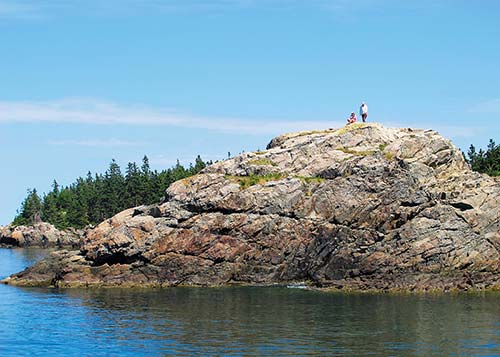
Spend at least a few hours hiking in Isle au Haut’s Acadia section.
A park ranger meets the boat that docks in Duck Harbor and provides a brief orientation for visitors. The biggest mistake most day-trippers make is overestimating how much terrain they can cover. It’s wise to confer with the ranger about plans, especially if you’re not an avid and experienced hiker. Be sure to top off water bottles at the pump. There’s also a composting toilet available.
Distance: 7.6 miles round-trip
Duration: 4 hours
Elevation gain: Minimal
Effort: Moderate
Trailhead: Park Ranger Station, north end of the island
The most-used park trail connects the town landing with Duck Harbor. You can either use this trail or follow the island road—mostly unpaved in this stretch—to get to the campground when the summer ferry ends its Duck Harbor runs.
Distance: 2.4 miles round-trip
Duration: 3-4 hours
Elevation gain: 300 feet
Effort: Strenuous
Trailhead: Western Head Road
Even though the summit is only 314 feet, this is the island’s toughest trail. Still, it’s worth the effort for the stunning, 360-degree views from the summit. Rather than return via the trail’s steep, boulder-strewn sections, you can cut off at the Goat Trail and return to the trailhead that way.
Distance: 4 miles round-trip
Duration: 2 hours
Elevation gain: 150 feet
Effort: Moderate
Trailhead: Western Head Road
For terrific shoreline scenery, take these two trails, at the island’s southwestern corner, that form a nice loop around Western Head. The route follows the coastline, ascending to ridges and cliffs and descending to rocky beaches, with some forested sections. You can close the loop by returning via the Western Head Road. If the tide is out (and only if it’s out), you can walk across the tidal flats to the quaintly named Western Ear for views back toward the island. The Goat Trail adds another four miles (round-trip) of moderate coastline hiking east of the Cliff Trail; views are fabulous and birding is good, but if you’re only here for a day, you’ll need to decide whether there’s time to catch the return boat. If you do have the time and the energy, you can connect from the Goat Trail to the Duck Harbor Mountain Trail.
Distance: 3 miles one-way
Duration: 2 hours
Elevation gain: 150 feet
Effort: Strenuous
Trailhead: Main road, western side of the island
This difficult loop hike crosses from the west to the east side of the island and passes along a ridge paralleling Long Pond before climbing along the edges of Bowditch Mountain’s summit. The trail intersects with the Median Ridge Trail (1.6 miles of moderate terrain to where it intersects with the main road) and the Bowditch Trail.
Distance: 4 miles round-trip
Duration: 2-3 hours
Elevation gain: 350 feet
Effort: Moderate
Trailhead: Off Duck Harbor Trail, 1.5 miles from the ranger station
The Bowditch Trail passes through bogs, forests, and wet ledges as it climbs to the mountain’s 405-foot summit, where it connects to the Median Ridge-Long Pond Trail. Varied terrain and good views make the effort worthwhile.
Befriend a local and ask for directions to Seal Trap, an easy trail to a postcard-worthy harbor on the island’s west side. (The name, by the way, evolved from Ciel Trappe, which means Sky Trap and has nothing to do with seals). The unmarked trail crosses private property, so do ask locally whether you can hike it, and practice good trail etiquette. Another unmarked trail is Mount Champlain, a moderate hike up to the 543-foot summit, which provides few views because it’s heavily forested. Access is on the north end of the island.
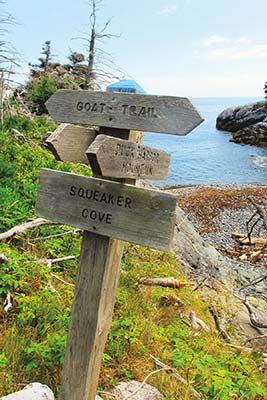
Hike in relative solitude on Isle au Haut.
When the water is rough, Boom Beach, on the island’s east side, is the place to be. As crashing waves roll in over the round rocks, they rumble, hence the boom. The stormier it is, the wilder this spot becomes. It’s an easy five-minute walk to the stone beach from the main road (the only road) along a spruce-lined path edged with moss- and lichen-covered rocks. Bring a picnic, but don’t even consider swimming here. Boom Beach is approximately 0.25 mile north of Long Pond beach; look for a grassy pullout.
If you’re traveling counterclockwise around the island, take the first road on the right just north of Head Harbor, when the road turns to tar (you’ll see a bright yellow house just down the road); across from the log cabin in the field, follow the mowed path to the shore, then look for a sign for Thunder Gulch. Follow the trail through the woods and down the middle of Eastern Head. Tension seems to build as you walk through the woods, and then the trail emerges to open ocean views. Waves roll into a cleavage in the rock before erupting in a tower of spray. One islander describes it as a Zen-like place “where all your questions will be answered.”
In Duck Harbor, park rangers suggest Eben’s Head as a great trail for those visiting with young children. It’s a short, easy loop skirting the coastline and taking in two cobble beaches that are ideal for beachcombing and splashing. An offshoot climbs a rocky knob guarding the entrance to Duck Harbor, a fine place for a picnic, but keep youngsters away from the edges. The trail is on the park map, and the ranger who meets the boat can provide directions.
Isle au Haut’s offshore location makes it a popular stopover for migrating bats; shorebirds, including purple sandpipers; songbirds; and raptors, including bald eagles. It’s also renowned as a wintering haven for harlequin ducks.
Pedaling is limited to the 12 or so miles of hilly roads: 5 miles paved, and 7 with loose gravel and ledges. While cycling is a way to get around, frankly, the terrain isn’t exciting, fun, or view-worthy. Mountain bikes are not allowed on the park’s hiking trails. You can rent a bike (about $25/day) for the island from the Isle au Haut Ferry Service or Old Quarry Ocean Adventures. It costs $22 round-trip to bring your own bike aboard the Isle au Haut ferry. Both boats carry bikes only to the town landing, not to Duck Harbor.
For freshwater swimming, head for Long Pond, a skinny, mile-long swimming hole running north-south on the east side of the island, abutting national park land. You can bike over there, clockwise along the road, almost five miles, from the town landing. Or bum a ride from an island resident. There’s a minuscule beach-like area on the southern end with a picnic table and a float. If you’re here only for the day, though, there’s not enough time to do this and get in a long hike. Opt for the hiking—or do a short hike and then go for a swim (the shallowest part is at the southern tip).
Although Isle au Haut is pretty much a make-your-own-fun place, summer events usually include a Fourth of July parade, which all islanders participate in, so there are few spectators, and an island talent show in August. Look also for signs at the town landing dock about themed cook-offs, which might include such gourmet items as Spam.
If visiting with young children, there are swings and a cedar climbing gym at the Isle au Haut School, a one-room schoolhouse for children in grades K-8. The Revere Memorial Library (www.revere.lib.me.us) has an excellent children’s room.
One doesn’t go to Isle au Haut to shop, but if you want to purchase books by island authors, Maine-made jewelry and gifts, or other souvenirs, Kendra Chubbuck’s Shore Shop Gifts (1 Main Rd., 207/335-2244, www.maineshoreshopgifts.com) is well worth a visit. The shop is in the village, just north of the Town Dock
The Island Store (207/335-5211, www.theislandstore.net), just north of the Town Dock, stocks essentials and a few splurge-worthy items.
Jeff Burke shows his portraits at the tiny Pretty Good Gallery.
Isle au Haut is pretty much a BYO place—and for the most part, that includes BYO food.
Thanks to the Isle au Haut General Store (207/335-5211, www.theislandstore.net), less than a five-minute walk from the town landing, you won’t starve. The summer inventory includes all the makings for a great picnic. On the other hand, food probably won’t be your prime interest here—Isle au Haut is as pretty as it gets.
And then there’s The Maine Lobster Lady (207/669-2751, www.mainelobsterlady.com, 7:30am-6pm Tues.-Sun., $12-20), Diana Santospago’s seasonal takeout serving lobster in many forms, chowders, and fried seafood and whoopie pies as well as breakfast sandwiches, pies, milk shakes, ice cream, and iced coffee. Find her parked at the General Store. There are picnic tables with umbrellas on the thoroughfare’s edge.
Escape to S The Keeper’s House (P.O. Box 26, Lighthouse Point, Isle au Haut 04645, 207/335-2990, www.keepershouse.com, from $325), an inn housed in a light station. Connected by boardwalk to the automated Robinson Point Light and within night sight of three other lighthouses, the inn is a truly special, all-inclusive, eco-friendly, rustic retreat. It’s off the grid, with power supplied by photovoltaics, and fresh water is supplied through a reverse osmosis system. The spacious top-floor Garret Room, tucked under the eaves—perhaps not the best choice for tall folks—has a private bath. The three other rooms in the main building share a bath. The best view is from the Keeper’s Room, overlooking the light tower and Isle au Haut Thorofare. Detached from the main house are the rustic Oil House, with a private outhouse, and the Woodshed, with two bedrooms, kitchenette, and bath. Guests relax outdoors or gather in the small living room. Rates include breakfast, lunch, and candlelight dinners as well as use of mountain bicycles and a rowboat. Adding to the yesteryear ambience are a 1924 Model T Doctor’s Coupe and a 1928 AA Ford commercial vehicle, both parked at the inn. Guests may have the opportunity to cruise aboard the inn’s restored 1949 Isle au Haut lobster boat or Friendship sloop. In season, the Isle au Haut Boat Company stops at the inn’s dock. BYOB and pack a light. Battery-powered electricity, no phones, no TV, no Internet, no smoking, no credit cards, no pets, no stress. Nirvana.
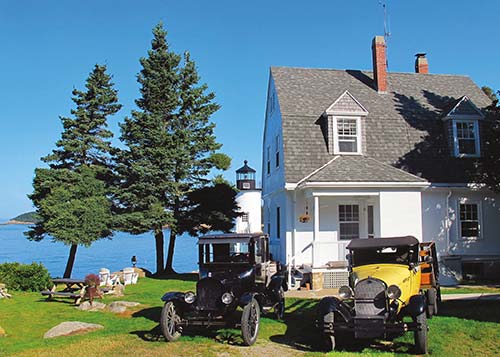
The Keeper’s House is the only overnight lodging on Isle au Haut.
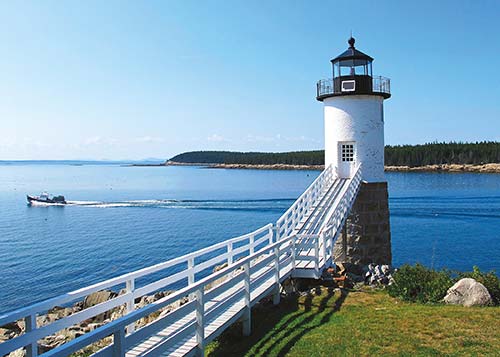
Robinson Point Light
As of 2018, reservations moved online (opening April 1 at 10am) for the five six-person lean-tos at Duck Harbor Campground (207/335-5551, www.recreation.gov). The season runs May 15-October 15; the fee is $20/night, and the maximum stay is three nights. You can only stay once during each calendar year.
Unless you don’t mind backpacking nearly five miles to reach the campground, try to visit between mid-June and late September, when the mail boat makes a stop in Duck Harbor. It’s wise to check with the Isle au Haut Boat Company (207/367-5193, www.isleauhaut.com) for the current ferry schedule before choosing dates for a lean-to reservation.
Note: Campers must carry all gear on/off the boat, which means navigating ramps and docks, and lean-to access is via a trail ascending through rocky and rooted terrain. The distance from boat to campground is roughly one-quarter mile.
Trash policy is carry-in/carry-out, so pack a trash bag or two with your gear. Also bring a container for carting water from the campground pump, since it’s 0.3 mile from the lean-tos. It’s a long walk to the general store for food—when you could be off hiking the island’s trails—so bring enough to cover your stay.
The three-sided lean-tos are big enough (8 by 12 feet, 8 feet high) to hold a small (two-person) tent, so bring one along if you prefer being fully enclosed. A tarp will also do the trick. (Also bring mosquito repellent—some years, the critters show up here en masse.) No camping is permitted outside of the lean-tos, and nothing can be attached to trees. If you’re even tempted by the idea of trying to sneak off and backpack into the park for an overnight, forget it. The island is small and rangers, boat captains, and locals keep track of the comings and goings; don’t risk federal fines.
Information about the section of Acadia National Park on Isle au Haut is available both online (www.nps.gov/acad) and at the ranger station (207/335-5551), about 0.3 mile from the town landing boat dock. General information on the island is available online from Isle au Haut Community Development Corporation (http://isleauhaut.org) and Isle au Haut Boat Company (www.isleauhaut.com).
Until recently, unless you had your own vessel, the only access to Isle au Haut’s town landing was the mail boat. That’s still the only way to get there year-round, but two companies now offer transportation to and from the island. Use Isle au Haut Boat Company if your destination is the park, as it lands right at Duck Harbor twice daily during peak season and is the only commercial operation allowed to do so.
If you disembark at the Town Dock, it’s a 4-5-mile journey via rugged road or trails to the other end of the park. If you’re overnighting at the Keeper’s House, you can shuttle via the mail boat’s park service for an additional rate (about $8 each way); ask the inn to radio the captain. While it may appear as if you can easily pedal from the Town Dock to Duck Harbor, it requires a mountain bike; even then, you’ll be walking it on many sections. A mountain bike is fine for pedaling around the town end of the island and out to Long Pond (expect hills). From there, you can hike into the park.
Private boats can anchor in Duck Harbor, but there are no moorings. Dinghies can be tied up on one side of the float, as marked.
The Isle au Haut Boat Company (Seabreeze Ave., Stonington, 207/367-5193, www.isleauhaut.com) generally operates five daily trips Monday-Saturday, plus two on Sunday mid-June-early September, to the Town Dock. Other months, there are two or three trips Monday-Saturday. The best advice is to request a copy of the current schedule, covering dates, variables, fares, and extras.
Round-trips April-mid-October are $40 adults, $20 kids under 12 (two bags per adult, one bag per child). Round-trip surcharges include bikes ($22) and kayaks/canoes ($46 minimum). Weather seldom affects the schedule, but be aware that heavy seas could cancel a trip.
There is twice-daily ferry service, early June-mid-September, from Stonington to Duck Harbor, at the edge of Isle au Haut’s Acadia National Park campground. For a day trip, the schedule allows you 4.5 hours on the island Monday-Saturday and 5 hours on Sunday. No boats or bikes are allowed on this route, and no dogs are allowed in the campground. A ranger meets the boat in Duck Harbor and provides and orientation and checks in campers. Before mid-June and after Labor Day, you’ll be off-loaded at the Isle au Haut town landing, about five miles from Duck Harbor. The six-mile passage from Stonington to the Isle au Haut town landing takes 45 minutes; the trip to Duck Harbor is 1.25 hours.
Ferries depart from the Isle au Haut Boat Company dock (Seabreeze Ave., off E. Main St. in downtown Stonington). Parking ($10) is usually available next to the ferry landing. Arrive at least an hour early to get all this settled so you don’t miss the boat. Better yet, spend the night on Deer Isle before heading to Isle au Haut.
Also offering seasonal service to Isle au Haut is Old Quarry Ocean Adventures (Stonington, 207/367-8977, www.oldquarry.com), which transports passengers on the Nigh Duck. The boat usually leaves Old Quarry at 9am and arrives at the island’s town landing at 9:45am, returning from the same point at 5pm. The fee is $39 round-trip for adults, $26 for children under 12. Bring your own bike for free or rent one from Old Quarry for $23/day. The boat can carry kayaks for $10.50. Old Quarry also offers a taxi service to Isle au Haut for $175 each way. Note: Old Quarry only services the Town Dock, not the park dock.